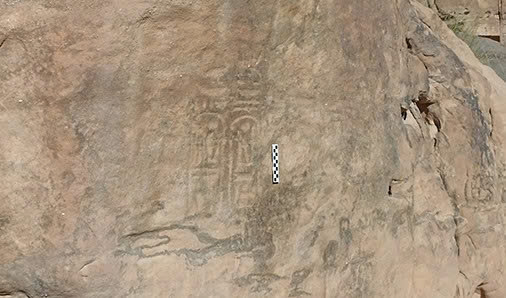A groundbreaking archaeological discovery has emerged from the remote desert landscapes of southern Jordan, where researchers have uncovered a remarkable hieroglyphic inscription bearing the royal seal of one of ancient Egypt’s most powerful pharaohs. This extraordinary find promises to reshape our understanding of ancient diplomatic and cultural exchanges across the Arabian Peninsula.
The Discovery That Rewrites History
Deep within the dramatic sandstone formations of the Wadi Rum region, archaeologists working near the Saudi Arabian border have made what experts are calling a “transformative discovery.” Carved into the weathered rock face, they found dual royal cartouches—ancient Egyptian name seals—belonging to Pharaoh Ramses III, who ruled the mighty Egyptian empire from 1186 to 1155 BCE.

The inscription represents the first documented evidence of an Egyptian royal cartouche ever discovered within Jordan’s borders, marking a historic milestone in Middle Eastern archaeology. The dual seals display both the pharaoh’s birth name and his official throne name, definitively confirming his sovereignty over the unified kingdoms of Upper and Lower Egypt more than three millennia ago.
Significance Beyond Borders
Jordan’s Minister of Tourism and Antiquities, Lina Annab, emphasized the discovery’s profound implications during a recent press conference. She described Jordan as “a living archive of human civilization,” noting that this find represents a “transformative contribution” to the country’s already impressive collection of ancient inscriptions and archaeological treasures.
The discovery has captured the attention of international archaeological communities, with renowned Egyptian archaeologist Dr. Zahi Hawass declaring it “monumentally important.” According to Hawass, this find could “unlock new chapters in our understanding of Egypt’s diplomatic and military relationships with neighboring regions over three thousand years ago.”
A Collaborative Archaeological Effort
This remarkable discovery emerged from an ongoing joint research initiative between Jordan’s Ministry of Tourism and Antiquities and the Saudi Heritage Commission. The collaborative project forms part of a comprehensive effort to trace and document evidence of Ramses III’s extensive military campaigns and cultural influence throughout regions beyond Egypt’s traditional boundaries.
Historical Context and Imperial Reach
The Pharaoh’s Turbulent Era

Ramses III governed Egypt during one of the ancient world’s most chaotic periods. The Eastern Mediterranean was experiencing widespread political collapse, with the mighty Hittite Empire crumbling and Mycenaean Greek civilizations falling into decline. During this tumultuous time, Egypt faced relentless attacks from both land-based armies and maritime invaders.
The pharaoh’s military prowess became legendary, particularly following his decisive victory in the Battle of the Delta, where he successfully repelled the mysterious “Sea Peoples”—a confederation of unknown invaders who had terrorized the Mediterranean coastlines.
Trade Routes and Strategic Influence
While Jordan never officially belonged to the Egyptian Empire, its strategic location along crucial trade corridors connecting Egypt with the Levant and Arabian Peninsula made it a region of significant interest. The presence of a royal seal in this remote desert location suggests that Egypt’s sphere of influence—whether military, political, or cultural—extended far beyond previously documented territories.
This discovery provides compelling evidence that Egyptian authority and diplomatic reach penetrated deep into the Arabian Peninsula, utilizing the extensive network of trade routes that crisscrossed the region.
Video
Looking Forward: Research and Future Excavations
Ongoing Analysis
Archaeological teams are currently conducting comprehensive analysis of the inscription, employing advanced imaging techniques and comparative studies to extract maximum information from this ancient text. The detailed research aims to uncover additional insights about the specific circumstances that led to this royal marking being carved in such a remote location.
Expanding the Search

Officials have indicated that pending the completion of current research, additional excavation campaigns may be launched in the surrounding area. The possibility of discovering related artifacts or inscriptions could further illuminate the extent and nature of ancient Egyptian activities in this strategically important region.
The discovery stands as a testament to the sophisticated diplomatic and military networks that connected ancient civilizations across vast distances, revealing how powerful empires like Egypt maintained influence and presence far beyond their traditional heartlands through a complex web of trade, military campaigns, and cultural exchange.

